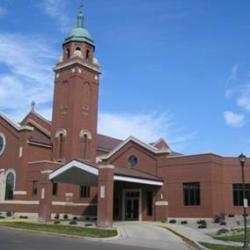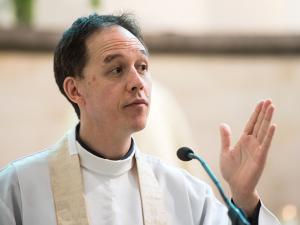
Celebrations of Grace: The Sacraments of the Catholic Church, Part 10
I was walking through the vestibule of a local Lutheran church and peering into the sanctuary. (The word “sanctuary” means interestingly different things for Lutherans and Catholics; but see below for that.) As I was saying, I was walking, along with the church’s pastor, and peering, and I noticed a lighted sanctuary lamp. In Catholic churches that lamp signals the real presence of Christ in the tabernacle. I wondered what it meant in this Lutheran church. Lutherans don’t reserve Eucharistic elements, consecrated hosts, in a special place between liturgies.
I asked the pastor why that lamp was lit. He informed me—like I should have known—that it means God is present there. But I persisted, noting the difference in Catholic and Lutheran practice and belief. Those beliefs are not as different as I was taught ages ago. Lutherans have assured me that Jesus is really, not just symbolically, present in the Eucharistic celebration. We differ in that Catholics believe – and Lutherans do not – that Jesus’ presence continues in any Eucharistic elements that remain after the communion rite. The Lutheran pastor answered simply, “God is present everywhere.”
The sanctuary
That answer wasn’t immediately helpful, but it got me thinking about real presence. If God really is present everywhere, shouldn’t we have sanctuary lamps all over the place? Of course, that’s impossible. I suppose having one lamp perpetually lit in this one special place may be the Lutheran way of holding in mind and honoring God’s real presence everywhere else.
I went back to that Lutheran church to get another view of the sanctuary lamp. Without a tabernacle nearby, it seemed to be shining for the space where people gather. The Lutheran term for that whole space is “sanctuary.” Catholics call “sanctuary” the smaller space where the altar and tabernacle sit and the liturgical ministers perform their tasks. We call the space for the assembly of the people the “nave.” Such a plain term for such an important space! If my argument below has merit, we could adopt the Lutheran usage and be clearer about what real presence is.
Real presence
With the practice of reserving hosts in a tabernacle, Catholics have a concrete way of relating to different kinds of presence. But it’s a bit puzzling. We believe in a real presence of Jesus in that one special place and also in a presence that we don’t usually call real everywhere else.
The opposite of real is imaginary, but Jesus’ presence in the stranger and in the sunset surely isn’t imaginary or even merely symbolic. (Ironically, there seem to be a lot of Catholics who think Jesus’ presence in the Eucharist is merely symbolic.) We need some different vocabulary as an alternative to “real,” “imaginary,” and “symbolic.”
The Body of Christ
Or some older vocabulary. William T. Cavanaugh (see this post) explains a switch in the way Catholics have spoken of the Body of Christ in the Church and in the Eucharist. Following Paul, the Church has always thought of her members as parts of the Body of Christ. On the same theme Pope Pius XII wrote the encyclical “The Mystical Body of Christ” my early favorite image of the Church. But Paul didn’t use the term “mystical.” “Mystical Body,” in Church history, originally referred to the Body of Christ in the Eucharist! How did we get from Eucharistic “Mystical Body” to Eucharistic “Real Presence”?
According to Henri de Lubac’s research, which Cavanaugh follows, in the 12th century the Eucharist became “Corpus Verum,” the True Body of Christ. Then Catholics needed a new term for the Church, and “mystical” was newly available. The Church became the “Mystical Body of Christ.”
The Church has a visible, institutional body, of course. At least as my young self imagined it, there had to be something else there—hidden, invisible, interior—the mystical body of Christ. And I loved that image from Pius XII’s encyclical.
Cavanaugh advocates going back to the original usage. The Church, with its people and their visible structure, practices, doctrines, is Christ’s True Body in the world. Jesus is not there like a reality over, under, or inside the visible forms that we see. True bodies are those visible things. But in the Eucharist we do describe Jesus’ presence as in or under the forms of bread and wine and in the sharing of a meal. That’s the kind of presence that a mystical body would have. We just might want to begin saying, once again, the Eucharist is the Mystical Body of Christ.
Levels of realness
The presence of Christ in the Eucharist is real, as real as God’s mysterious activity. But Catholic piety sometimes pays more attention to the physical elements of the Eucharist, especially the consecrated host, than to the Eucharist as an action of the Church with Christ. (The Blessed Sacrament and its cult, or worship, will be the subject of a later post.) So when we think of real presence, we imagine Jesus being present in the same way as a physical thing is present. Before it was bread standing before us. Now it’s Jesus, hidden, but standing before us just as the bread was doing before. That’s a real presence, alright, but is it real enough for the Eucharist?
One of the things I love about the Catholic Church is the positive attention she pays to the world of matter. This world is not a place to get through on our way to somewhere else. It’s a creation that God loves for its own sake. It praises God in its own unique way, and it enters into the Church’s praises, especially in the sacraments. But it’s a created world, not a self-standing one. It owes its reality to Another. That, in fact, is its glory, but it’s a glory that it must attribute to God. God is the “really real,” who has reality naturally, not by gift.
Catholic theology speaks of uncreated grace, grace that is identical with the uncreated God. The grace of the Eucharist, as of all the sacraments, is like that. So when we celebrate a sacrament, we are in the presence of the One who is more real than we can imagine, the source of all reality.
Mystical presence
I don’t think we can immediately dispense with the phrase “real presence” of Christ in the Eucharist. But we should be clear that “real presence” also applies to Jesus in the poor, in the People of God, in nature. We should begin to imagine the sanctuary lamp shining to honor that presence in the world, a world to which Jesus in the form of bread wants to go as viaticum and food for the sick.
I suggest two vocabulary changes. We could begin referring to Jesus’ “mystical presence” in the sacraments—a super-real kind of presence. We could also upgrade what we call the nave to the status of sanctuary, holy place. Let the sanctuary lamp’s light shine out from the tabernacle to the entire gathering place of the holy People of God. Let the people imagine the light of the sanctuary going on and on to the farthest reaches of God’s real presence in the world.
Image credit: Wikimedia Commons via Google Images












